West Nile virus (WNV) rash is a dermatological manifestation seen in some individuals infected with the West Nile virus, which is transmitted primarily through the bite of an infected mosquito. It is a single-stranded RNA virus that belongs to a family of viruses called Flaviviridae. Mosquitoes that infect humans are either Anopheles, Aedes, or Culex. Culex is the most common form that infects human beings. The West Nile virus can also infect birds, horses, and dogs other than humans.1Salinas, J. D., Jr MD. (n.d.). West Nile Virus: Practice essentials, pathophysiology, epidemiology. https://emedicine.medscape.com/article/312210-overview?form=fpf#a1
While many people infected with WNV may show no symptoms, some may develop mild to severe illness, including fever, skin rash, headache, body aches, and, in more serious cases, neurological conditions like encephalitis or meningitis.
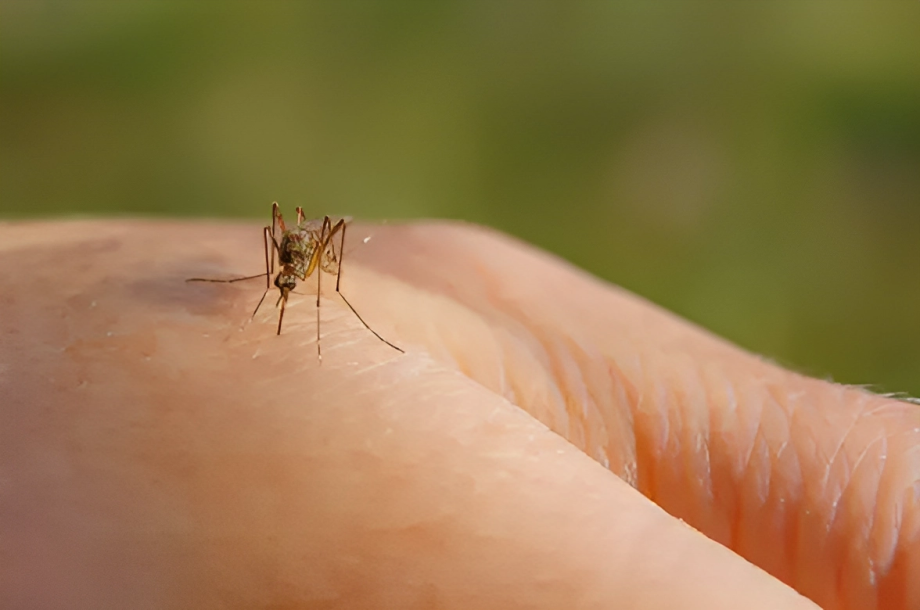
How Common is the West Nile Virus?
The West Nile virus started to appear in some countries in 1937. After 1999, it spread drastically in several countries. Many cases have been reported since 1999. West Nile virus is present in Europe, Asia, Africa, Australia, and the Middle East nowadays.
About 1 in 5 people who get the virus also show symptoms of West Nile virus.2Clark, M. B. (2023, August 8). West Nile virus. StatPearls – NCBI Bookshelf. https://www.ncbi.nlm.nih.gov/books/NBK544246/
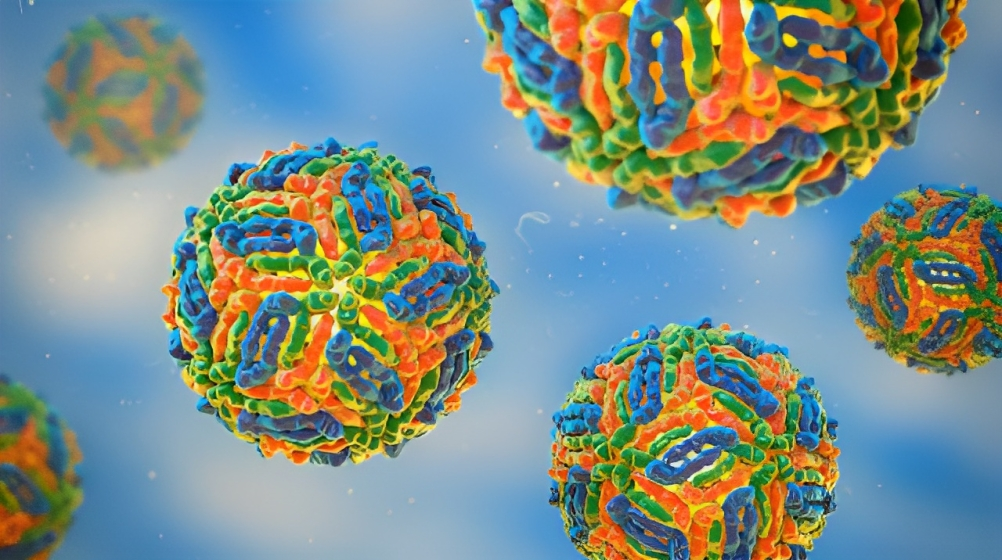
How is the West Nile Virus Transmitted?
The transmission cycle of the West Nile virus circulates between the vector, a mosquito, the reservoir host (the birds), and the dead-end host, either human beings or horses.
West Nile virus naturally lives and reproduces in the reservoir host, the birds. When a mosquito bites a bird with the West Nile virus, it becomes infected. Viruses are present in the salivary gland of the infected mosquito. When an infected mosquito bites humans, the virus enters into their bloodstream. These mosquitoes also transmit the disease to other mammals like horses. Humans and horses are the dead-end hosts in the life cycle of the West Nile virus. It means that they cannot transmit the disease further to other mammals. Mosquitoes also transmit the disease from one infected bird to another healthy bird.
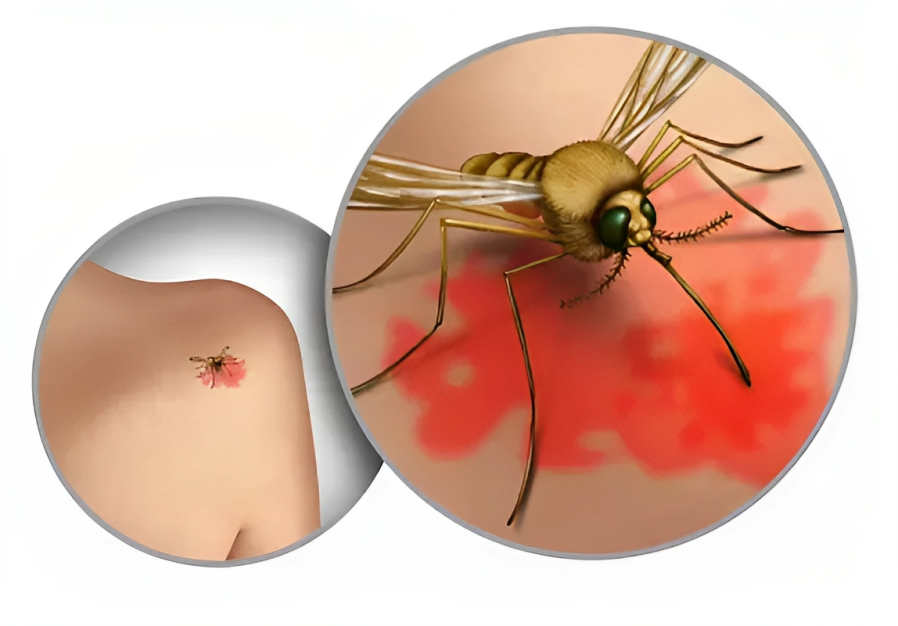
When an infected mosquito feeds on humans and transmits the West Nile virus through its saliva, the virus goes through three phases inside human beings. These phases are:
- Replication Phase: In this phase, the virus replicates and completes its life cycle within the skin cells.
- Dissemination Phase: The virus enters the lymph nodes of humans and subsequently spreads to your organs.
- Final Phase: In the final phase of the transmission cycle, the virus enters your central nervous system and causes inflammation and loss of neurons. This entry causes complications of the disease.3Hayes, E. B., Komar, N., Nasci, R. S., Montgomery, S. P., O’Leary, D. R., & Campbell, G. L. (2005). Epidemiology and transmission dynamics of West Nile virus disease. Emerging infectious diseases, 11(8), 1167–1173. https://doi.org/10.3201/eid1108.050289a
Symptoms of West Nile Virus
Symptoms start to appear 4-14 days after the infected mosquito bites. This is an incubation period of the West Nile virus. These symptoms persist for almost a week and then disappear. The following are the common symptoms of West Nile virus:
- Low-grade fever
- Myalgia (muscle ache)
- Malaise (feeling of weakness)
- Rash
- Vomiting
- Anorexia
- Eye pain
The fever mostly persists for five days, but you can feel the general weakness for almost a month.4Frellick, M. (2023b, August 15). West Nile infections rising in the US. Medscape. https://www.medscape.com/viewarticle/995399?form=fpf
West Nile Virus Rash
The West Nile virus rash is a skin manifestation associated with WNV infection, characterized by flat or slightly raised red spots primarily on the trunk, neck, and extremities. The rash is usually macular or papular. Although not always present, it may accompany flu-like symptoms such as fever, headache, and fatigue. The rash usually appears 4–7 days after the onset of symptoms and accompanies the onset of fever. It lasts between 7 and 14 days and resolves with the improvement of other symptoms.5 Gorsche R, Tilley P. The rash of West Nile virus infection. CMAJ. 2005 May 24;172(11):1440. doi: 10.1503/cmaj.1041013. PMID: 15911857; PMCID: PMC557978.
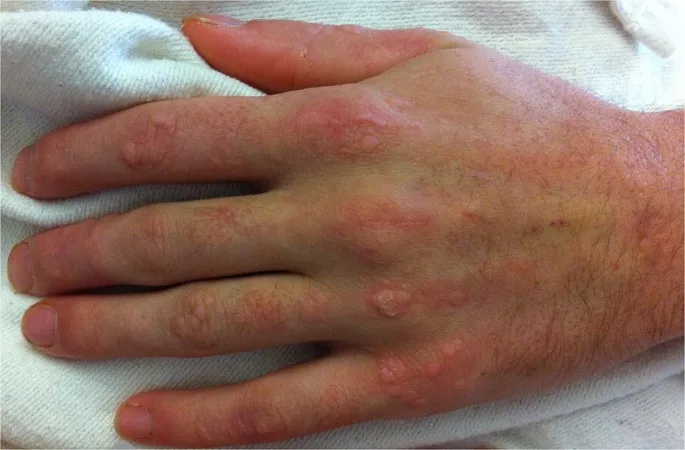
Complications of West Nile Virus
In rare cases, the West Nile virus enters the central nervous system and causes complications. The virus causes inflammation of the meninges and loss of neurons, causing serious complications. These complications are:
- Severe headache
- Changes in mental state
- Memory loss
- Severe muscle weakness
- Neck stiffness
- Seizures
- Flaccid paralysis
- Retinal hemorrhages
- Cardiac problems
- Coma
- Death
Patients having neurological symptoms require ICU management and proper mechanical ventilation. The mortality rate of patients having serious symptoms of the West Nile virus is high.6Clark, M. B. (2023c, August 8). West Nile virus. StatPearls – NCBI Bookshelf. https://www.ncbi.nlm.nih.gov/books/NBK544246/
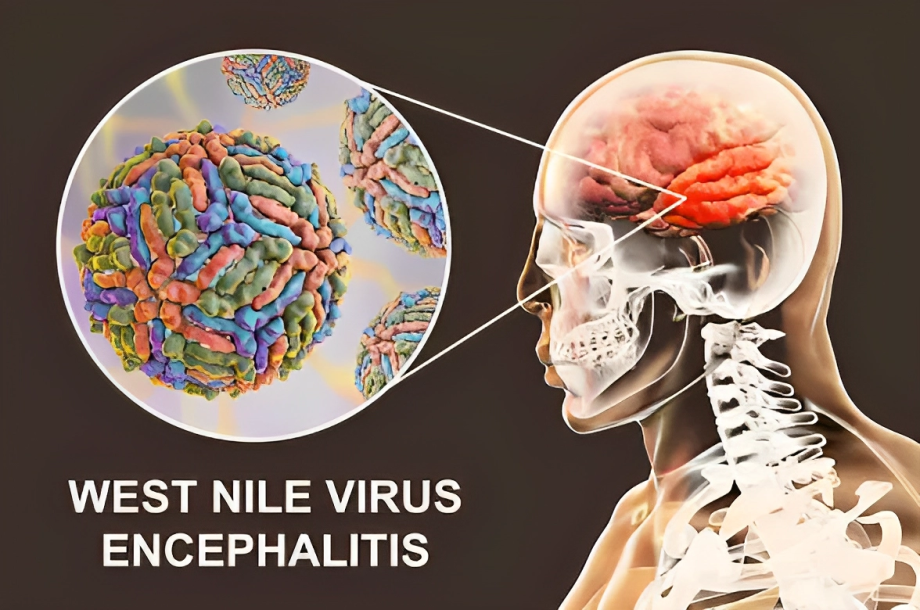
What are the Risk Factors for West Nile Virus?
Any factor that weakens your immune system increases the risk of getting the West Nile virus. Following are some of the risk factors of West Nile virus:
- Age more than 60 years
- Hypertension
- Diabetes
- Cancer
- Presence of any other infection
How to Diagnose West Nile Virus?
West Nile virus is diagnosed by the following investigations:7Kemmerly S. A. (2003). Diagnosis and treatment of West Nile infections. Ochsner journal, 5(3), 16–17.
Complete Blood Count
CBC of the West Nile virus infection shows leukocytosis, i.e., an increase in the number of white blood cells. Generally, the presence of any viral infection causes an increase in the number of white blood cells.
Electrolytes
This shows hyponatremia (a decrease in the level of sodium in the blood). Hyponatremia occurs when the West Nile virus involves the CNS.
Enzyme-Linked Immunosorbent Assay
ELISA shows the presence of IgM antibodies in the samples of blood or cerebrospinal fluid.
Lumbar Puncture (LP)
When CNS symptoms are present, LP is done to confirm the presence of the virus. LP typically shows the picture of viral meningitis with an increase in protein levels and normal glucose levels.
Imaging
CT scan and MRI (Magnetic resonance imaging) detect the presence of West Nile virus after 2 or 3 weeks if it involves the central nervous system.

Treatment of West Nile Virus
No specific antiviral medications are present for the treatment of West Nile virus. Treatment of West Nile virus primarily depends upon symptomatic management. This includes:
Fluids
You must take as much fluids as you can because fluids keep you hydrated and improve your immunity. Intravenous fluids are used for hospital-admitted patients. This is the best way to treat viral infections.
Antipyretics
You can use antipyretics like paracetamol if you are having a fever. For high-grade fever, sponging is also used in addition to medicines.
Pain-killers
For muscle aches and generalized pain, you can take painkillers like NSAIDS.
Antiemetics
Antiemetics are used to treat nausea and vomiting associated with West Nile virus.
Antiseizure Drugs
Your doctor may prescribe you anti-seizure drugs like barbiturates or benzodiazepines if you are having tremors or seizures.
Rest
You should rest for a few days after getting an infection. Take fluids and eat healthily. It will help to improve your immunity against West Nile virus.
Multivitamins
Take multivitamins for almost a month. This helps to improve your immunity. You can recover early if you take rest and multivitamins properly.8Kemmerly S. A. (2003). Diagnosis and treatment of West Nile infections. Ochsner journal, 5(3), 16–17.
How can we prevent a West Nile Virus?
The best way to avoid getting the West Nile virus is to avoid the bite of mosquitoes as it spreads through the bite of an infected mosquito.9Nasci, R. S., & Mutebi, J. P. (2019). Reducing West Nile Virus Risk Through Vector Management. Journal of medical entomology, 56(6), 1516–1521. https://doi.org/10.1093/jme/tjz083
Take the following measures to prevent West Nile virus:
- Use mosquito repellent spray and lotion at night
- Wear a dress with long sleeves, especially at night.
- Use mosquito nets to sleep at night.
- Avoid the collection of water in tanks or coolers.
- Keep your surroundings clean to avoid transmission of the virus.
- Take measures to use insecticide spray at least every month.
- Avoid going or staying at places with mosquitoes or places that are not clean. Such places have a high risk of transmission of viruses.
Is West Nile virus Contagious?
No, West Nile virus cannot be transmitted from one person to another either by personal contact or air droplets. That is why it is not contagious.
However, if you get infected by the virus, you should rest completely to recover properly.
Is West Nile Virus a Serious Disease?
Initially, the West Nile presents with low-grade fever, flu-like illness, and skin rash. These symptoms are not serious, and you can recover from these symptoms in a few weeks. However, the West Nile virus can rarely enter your central nervous system and cause inflammation. The disease becomes serious in such patients. These patients need proper ICU care if they show CNS symptoms after getting infected by the virus, and their mortality rate also increases.10rellick, M. (2023, August 15). West Nile infections rising in the US. Medscape. https://www.medscape.com/viewarticle/995399#?form=fpf
Is there any Vaccine available for West Nile Virus?
Right now, no vaccine is available to treat West Nile virus. Most of the people exhibit symptoms like headache, fever, or rash. These symptoms require symptomatic treatment only. Moreover, no specific antiviral medications are available for West Nile virus.
What other diseases can mimic the Symptoms of West Nile Virus?
Symptoms of some other diseases resemble the symptoms of West Nile virus. It can cause confusion in diagnosing the disease. A doctor should differentiate the symptoms of West Nile virus from other diseases by taking proper travel history and extensive investigation. It helps to make a better diagnosis.
Differential diagnosis of West Nile virus are:
Bacterial Meningitis
Bacterial meningitis presents as fever and neck stiffness like the West Nile virus. However, the fever of West Nile virus is low-grade, and that of bacterial meningitis is high-grade. Further diagnosis depends upon the investigations like Complete blood count and lumbar puncture.
Dengue Virus
A doctor can easily differentiate between the symptoms of Dengue and West Nile viruses. Dengue virus presents as a rash, fever, and pain behind the eyes. The dengue rash looks like small papules all over the body, while the rash of West Nile virus is maculopapular, mostly on your extremities. Investigations further help to make the diagnosis properly.
Varicella-Zoster Virus (VZV)
Varicella-zoster virus causes chickenpox and shingles. A doctor can differentiate VZV and West Nile virus on the basis of rash. The rash of VZV starts as red bumps on the face and arms that change into fluid-filled blisters after some days, while the rash of West Nile virus is maculopapular, appearing on your extremities.
Herpes-Simplex Virus Type 1
HSV-1 presents as ulcers or cold sores on your lips and mouth. These ulcers are mostly fluid-filled and are itchy. In comparison, the rash of West Nile virus appears on your extremities and is not itchy.
Enteroviruses
Enteroviruses cause symptoms like the common flu, fever, runny nose, sneezing, or sore throat. They also cause a specific skin rash called hand-foot-and-mouth disease, as enteroviruses cause red sores in your mouth, palms, and soles. On the other hand, the West Nile virus causes a rash on your arms and legs. This rash is maculopapular, and West Nile virus usually does not cause sore throat or sneezing.
Some of the tick-borne diseases have symptoms that resemble the symptoms of West Nile virus.
These are:
Rocky Mountain Spotted Fever
Rash of Rocky Mountain Spotted fever presents some days after the fever. It appears on your wrists, ankles, and also on your palms and soles. It then spreads to your whole trunk. The rash appears as small pink flat macules on your body. However, the rash of West Nile virus appears mostly on your extremities.
Lyme Disease
A doctor can easily differentiate Lyme disease from West Nile virus by noticing their symptoms. In Lyme disease, you get a specific bull’s eye rash around the bite areas. It is known as erythema migrans and spreads to other parts of your body in a few weeks or months. However, the rash of West Nile virus does not appear on the bite area; it appears mostly on your upper and lower extremities.
Anaplasmosis
Anaplasmosis, transmitted through bites from infected Ixodes Scapularis ticks, brings symptoms such as fever, headache, muscle aches, nausea, and vomiting. Unlike some diseases, it typically does not result in a skin rash. Therefore, it is easy to differentiate between the symptoms of West Nile virus and Anaplasmosis.11Yu, A., Ferenczi, E., Moussa, K., Eliott, D., & Matiello, M. (2020). Clinical Spectrum of West Nile Virus Neuroinvasive Disease. The Neurohospitalist, 10(1), 43–47. https://doi.org/10.1177/1941874419868636
What is the Prognosis of West Nile Virus?
West Nile virus doesn’t cause serious symptoms, and you recover in a week or two. Therefore, the prognosis of West Nile virus is pretty good. Take rest, plenty of fluids, and the usual symptomatic treatment, and you will recover in almost ten days.
However, the mortality rate increases to 10% if West Nile causes serious CNS symptoms. West Nile virus becomes neuroinvasive, mostly in immunocompromised patients, and can become a reason for death.12Klee, A. L., Maidin, B., Edwin, B., Poshni, I., Mostashari, F., Fine, A., Layton, M., & Nash, D. (2004). Long-term prognosis for clinical West Nile virus infection. Emerging infectious diseases, 10(8), 1405–1411. https://doi.org/10.3201/eid1008.030879
What to see a doctor if you get West Nile Virus?
If you experience symptoms like severe vomiting, neck stiffness, memory loss, or seizure, consult your doctor as soon as possible. These symptoms indicate that the disease is getting serious, so immediate measures should be taken to treat the disease. However, if West Nile virus only causes symptoms like fever or headache, take the symptomatic treatment, and you will recover in some days.
Conclusion
In conclusion, the West Nile virus is a disease that is transmitted to us when an infected mosquito bites us. This mosquito gets the virus from an infected bird. Although West Nile virus is not a serious disease, you should still keep an eye on the symptoms if you get the infection. Seek medical advice if the disease is getting serious.
Refrences
- 1Salinas, J. D., Jr MD. (n.d.). West Nile Virus: Practice essentials, pathophysiology, epidemiology. https://emedicine.medscape.com/article/312210-overview?form=fpf#a1
- 2Clark, M. B. (2023, August 8). West Nile virus. StatPearls – NCBI Bookshelf. https://www.ncbi.nlm.nih.gov/books/NBK544246/
- 3Hayes, E. B., Komar, N., Nasci, R. S., Montgomery, S. P., O’Leary, D. R., & Campbell, G. L. (2005). Epidemiology and transmission dynamics of West Nile virus disease. Emerging infectious diseases, 11(8), 1167–1173. https://doi.org/10.3201/eid1108.050289a
- 4Frellick, M. (2023b, August 15). West Nile infections rising in the US. Medscape. https://www.medscape.com/viewarticle/995399?form=fpf
- 5Gorsche R, Tilley P. The rash of West Nile virus infection. CMAJ. 2005 May 24;172(11):1440. doi: 10.1503/cmaj.1041013. PMID: 15911857; PMCID: PMC557978.
- 6Clark, M. B. (2023c, August 8). West Nile virus. StatPearls – NCBI Bookshelf. https://www.ncbi.nlm.nih.gov/books/NBK544246/
- 7Kemmerly S. A. (2003). Diagnosis and treatment of West Nile infections. Ochsner journal, 5(3), 16–17.
- 8Kemmerly S. A. (2003). Diagnosis and treatment of West Nile infections. Ochsner journal, 5(3), 16–17.
- 9Nasci, R. S., & Mutebi, J. P. (2019). Reducing West Nile Virus Risk Through Vector Management. Journal of medical entomology, 56(6), 1516–1521. https://doi.org/10.1093/jme/tjz083
- 10rellick, M. (2023, August 15). West Nile infections rising in the US. Medscape. https://www.medscape.com/viewarticle/995399#?form=fpf
- 11Yu, A., Ferenczi, E., Moussa, K., Eliott, D., & Matiello, M. (2020). Clinical Spectrum of West Nile Virus Neuroinvasive Disease. The Neurohospitalist, 10(1), 43–47. https://doi.org/10.1177/1941874419868636
- 12Klee, A. L., Maidin, B., Edwin, B., Poshni, I., Mostashari, F., Fine, A., Layton, M., & Nash, D. (2004). Long-term prognosis for clinical West Nile virus infection. Emerging infectious diseases, 10(8), 1405–1411. https://doi.org/10.3201/eid1008.030879

